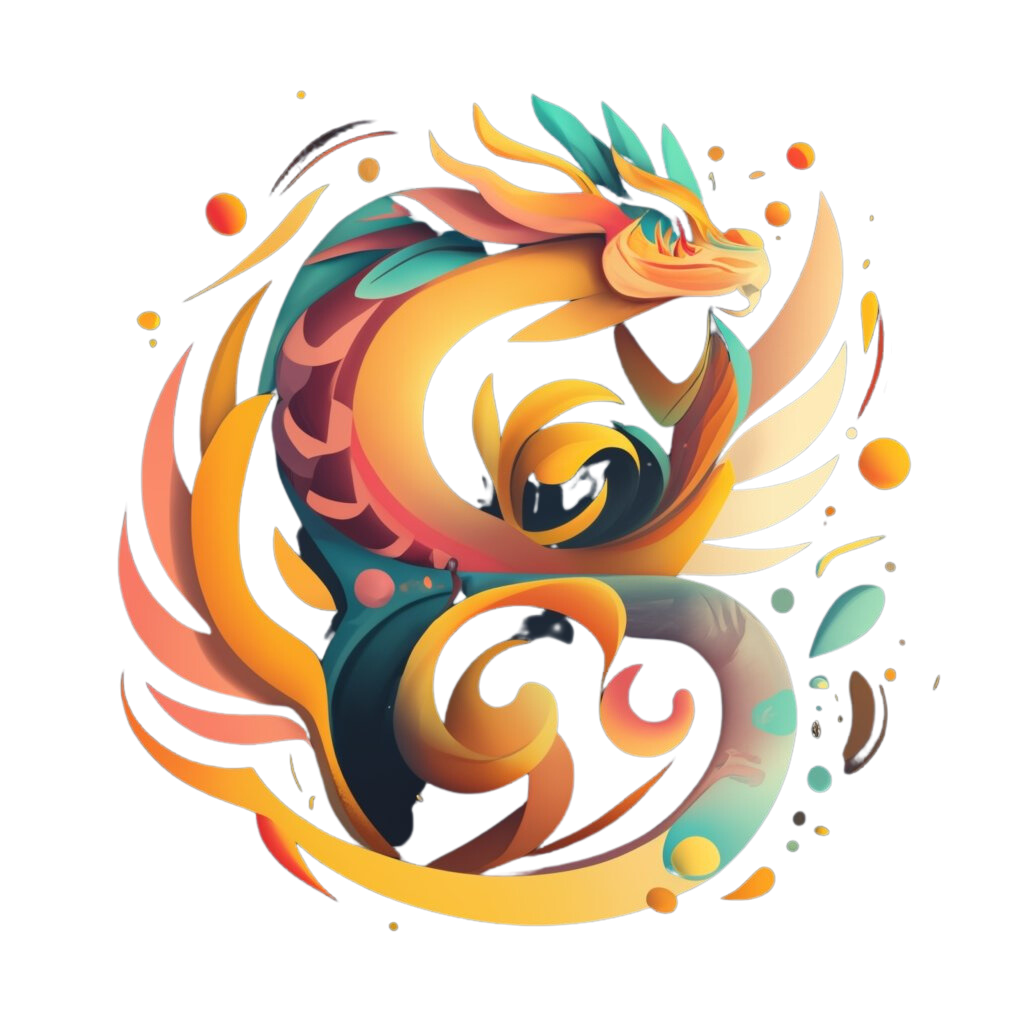Japanese mythical creatures have captivated people worldwide for centuries with their unique stories and characteristics. From mischievous fox-like creatures known as Kitsune to shape-shifting raccoon dogs called Tanuki, these mythical beings hold a significant place in Japanese folklore and culture.
Legend has it that Kitsune possess the ability to morph into different forms, often portrayed as playful or benevolent spirits in Japanese mythology. Tanuki, on the other hand, are known for their mischievous nature and transformative abilities, making them a popular subject in Japanese folklore.
Another intriguing mythical creature is the Tengu, a bird-like Yokai with both benevolent and malevolent characteristics. With its long nose and powerful wings, the Tengu has been a source of fascination in Japanese mythology for centuries.
The Kappa, a water-dwelling creature, and the Tsukumogami, objects that come to life, are also prominent figures in Japanese folklore. These creatures, with their unique traits and stories, continue to captivate people’s imagination and remain an integral part of Japan’s rich and diverse culture.
Key Takeaways:
-
- Japanese mythical creatures, such as Kitsune, Tanuki, Tengu, Kappa, and Tsukumogami, have captivated people worldwide with their unique stories and characteristics.
-
- These mythical beings hold a significant place in Japanese folklore and culture, showcasing the rich history and diversity of Japan’s mythical traditions.
-
- Kitsune are fox-like creatures with shape-shifting abilities, often portrayed as playful or benevolent spirits.
-
- Tanuki are mischievous raccoon dogs known for their transformative abilities and mischievous nature.
-
- Tengu are bird-like Yokai with both benevolent and malevolent characteristics, intriguing people with their long nose and powerful wings.
Uncover the Legends of Kitsune
Let’s delve into the enchanting world of Kitsune, the fox-like mythical creature that has intrigued generations with its magical powers. Kitsune, which means “fox” in Japanese, is a prominent figure in Japanese folklore and is often depicted as a shape-shifting creature with the ability to transform into a human or other forms. This duality is what makes Kitsune both fascinating and mysterious.
In Japanese mythology, Kitsune possesses wisdom and intelligence beyond that of an ordinary fox. They are believed to gain supernatural abilities and gain more tails as they age, with the most powerful Kitsune having up to nine tails. Each tail represents their age and wisdom, making them revered as divine beings.
The legends surrounding Kitsune vary, with some portraying them as mischievous tricksters while others depict them as benevolent protectors. They are associated with everything from bringing good fortune and ensuring abundant harvests to causing chaos and playing pranks on unsuspecting humans. This duality is a testament to the complex nature of Kitsune and the complexities of Japanese folklore as a whole.
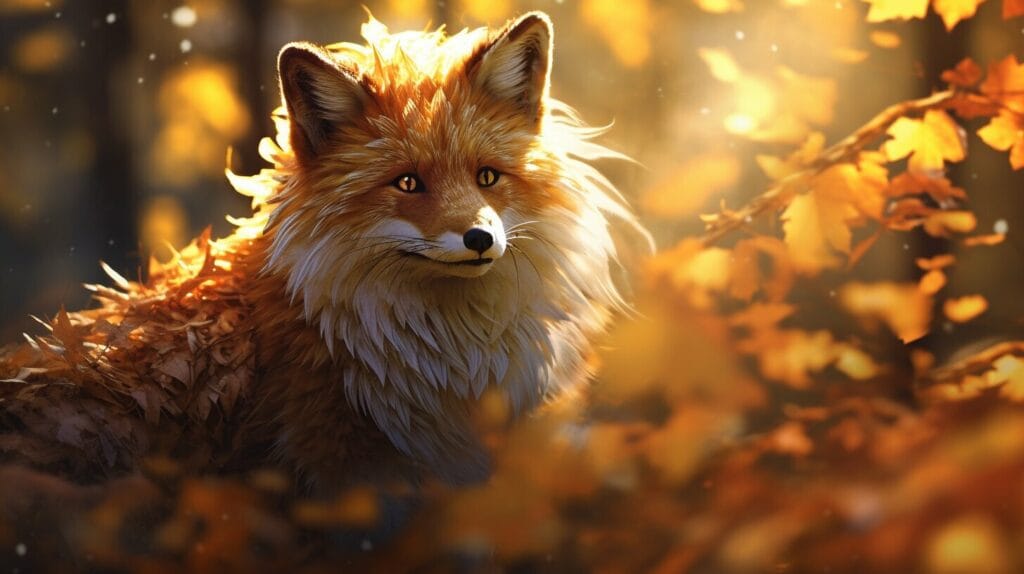
Kitsune or foxes are depicted both mischievous and wise creatures in Japanese folklore. They are often portrayed as shape-shifters,being able to shapeshift into humans or other animals. Kitsune are believed to possess intelligence and magical powers, and are associated with the element of fire.
They are known for their ability to bring good fortune, but can also be tricksters who play pranks on humans. In some stories, kitsune are seen as protectors and bringers of wealth and prosperity, while in others they are portrayed as malevolent beings who deceive and manipulate humans for their own gain. Overall, kitsune are revered and feared in Japanese culture, and their portrayal varies depending on the specific folktale or legend
As we explore the world of Japanese mythical creatures, the legends of Kitsune capture our imagination and captivate us with their intriguing nature. From their shape-shifting abilities to their intricate tales, Kitsune continues to be a beloved figure in Japanese culture and an enduring symbol of the rich folklore that weaves its magic throughout the land.
The Mischievous Tanuki in Japanese Folklore
Meet the mischievous Tanuki, a fascinating creature from Japanese folklore that is often seen as a symbol of good fortune and prosperity. Tanuki, also known as raccoon dogs, are known for their playful nature and transformative abilities.
In Japanese folklore, Tanuki are often depicted as chubby, jolly creatures with large eyes and a mischievous smile. They are believed to have shape-shifting abilities, allowing them to transform into various objects or animals. This transformative power is often used by Tanuki to play tricks on humans, such as transforming into a tea kettle or a tree stump.
These legendary creatures are also associated with fertility, abundance, and wealth. In fact, Tanuki statues are commonly found outside Japanese businesses and homes, believed to bring good luck and prosperity. The statues often depict a Tanuki holding a sake bottle and a promissory note, symbolizing wealth and good business.
| Tanuki Characteristics: | Symbolism: |
|---|---|
| Shape-shifting abilities | Good fortune and prosperity |
| Playful and mischievous | Fertility and abundance |
| Chubby and jolly appearance | Wealth and good business |
Legend has it that Tanuki are skilled drinkers and love to party. In folklore, they are often portrayed as wearing a straw hat and carrying a bottle of sake. Their jovial nature and love for festivities make them a popular subject in traditional Japanese art and literature.
The mischievous Tanuki continues to capture the imagination of people around the world. Their playful and carefree nature, combined with their association with good fortune, make them an enduring symbol in Japanese culture. Whether as statues adorning the streets of Japan or as characters in anime and manga, the Tanuki remains a beloved mythical creature that adds a touch of whimsy to the rich tapestry of Japanese folklore.
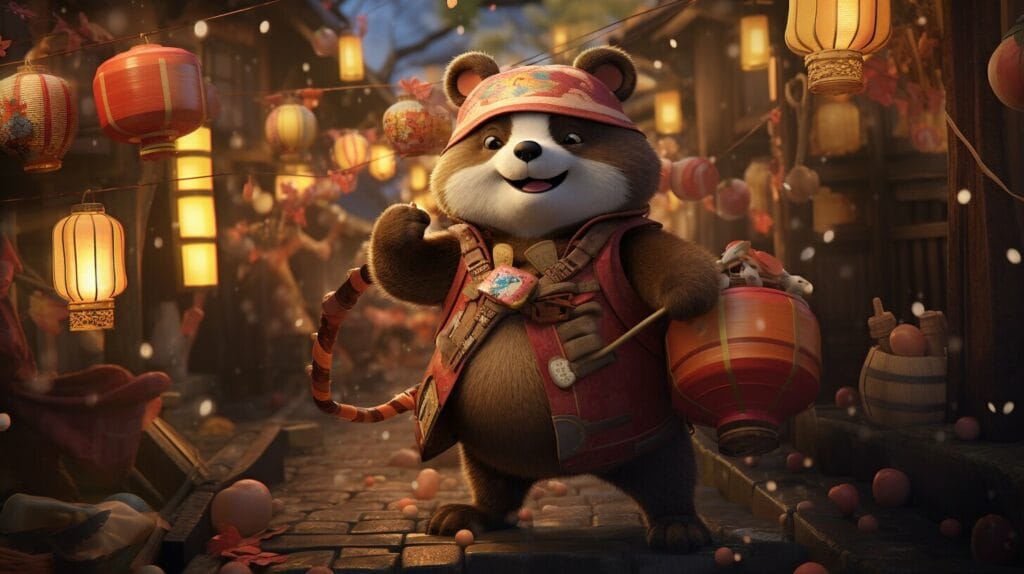
Discover the fascinating legend of the Tengu, the bird-like creature that has both intrigued and terrified people throughout Japanese mythology. Tengu are considered a type of yokai, legendary creatures with supernatural powers and abilities. In Japanese folklore, they are often depicted as bird-like creatures, with a mix of human and bird features. Their long noses and wings set them apart from other mythical creatures, making them instantly recognizable.
The Tengu are known for their incredible strength, intelligence, and penchant for mischief. They are said to reside in the mountains and forests of Japan, where they observe and sometimes interact with humans. Tengu are known as skilled martial artists and masters of swordsmanship, capable of manipulating the elements and shape-shifting at will.
According to legends, Tengu can be both benevolent and malevolent. They have a reputation for playing tricks on unsuspecting humans, but they can also serve as guardians and protectors of sacred places. Some stories depict them as wise hermits, imparting spiritual wisdom to those deemed worthy. However, they can also be vengeful and wrathful, punishing those who disrespect nature or engage in immoral behavior.
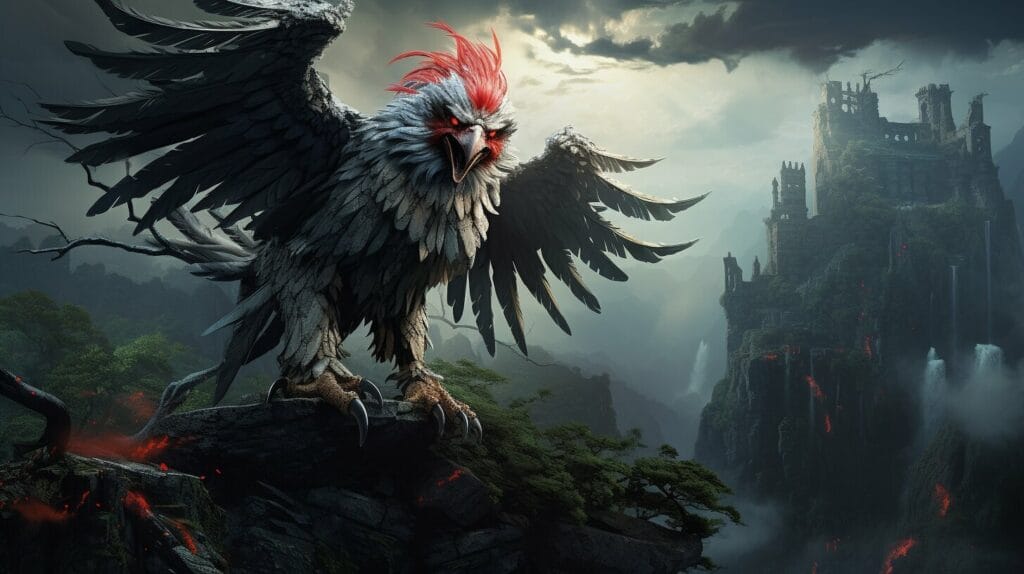
The Tengu has been a subject of fascination and interpretation in Japanese culture for centuries. They have found their way into various forms of art, including traditional woodblock prints and paintings. Their iconic appearance has been celebrated in literature, theater, and even video games. In modern popular culture, Tengu have become a beloved symbol of Japan’s rich supernatural heritage.
Legends surrounding the Tengu continue to inspire awe and curiosity. Their enigmatic nature and dualistic personalities make them captivating subjects for exploration. Whether seen as tricksters, guardians, or wise sages, the Tengu embody the complex relationship between humans and the supernatural in Japanese folklore.
References:
-
- “Tengu.” Yokai.com, www.yokai.com/tengu/.
-
- Cook, Scott. “The Complex Iconography of the Tengu.” Japanese Journal of Religious Studies, vol. 38, no. 2, 2011, pp. 383-402.
-
- Frederic, Louis. Japan Encyclopedia. Harvard University Press, 2002.
The Mysterious Kappa
Dive into the mysterious world of the Kappa, the water-dwelling creature that has captured the imaginations of people for centuries with its peculiar habits. In Japanese folklore, the Kappa is known as a mischievous and sometimes malicious creature that resides in rivers, lakes, and ponds. Its appearance is often described as a humanoid with green skin, a beak-like mouth, and a turtle-like shell on its back. However, what truly sets the Kappa apart is its unique anatomy, including a hollow indentation on its head filled with water, which grants it immense strength and power.
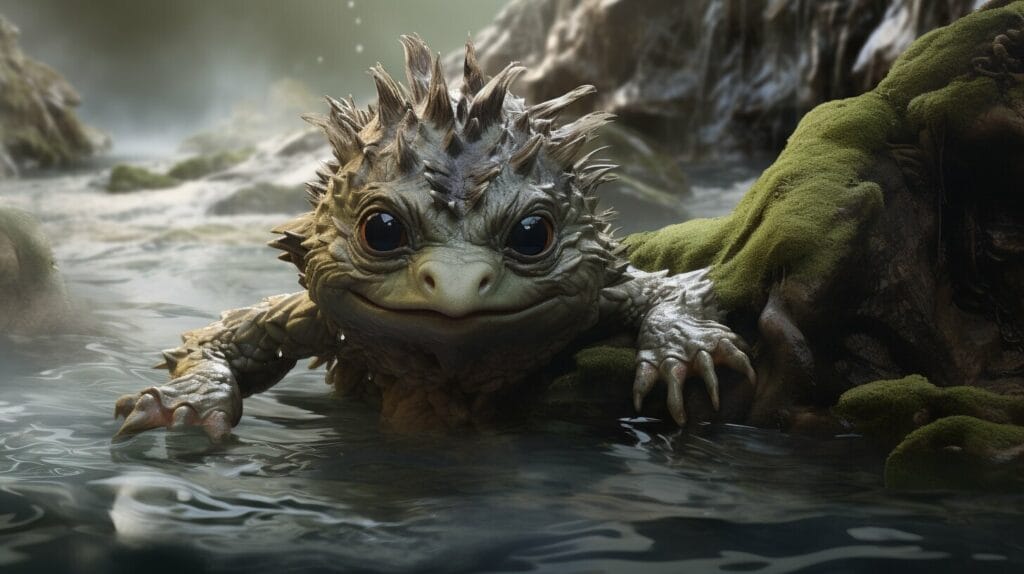
The Kappa is known for its mischievous nature and its penchant for playing pranks on unsuspecting humans. Legend has it that the creature has a particular obsession with cucumbers, and those who carry a cucumber with them are said to be safe from the Kappa’s tricks. However, if caught by a Kappa, one must bow deeply as a sign of respect, as the creature is easily distracted and will spill the water from its head, rendering it weak and vulnerable.
Despite their mischievous reputation, Kappas are also believed to possess extensive knowledge of medicine and martial arts. In fact, many traditional martial arts styles in Japan are said to have been influenced by the techniques used by these mythical creatures. This duality of the Kappa’s nature, both mischievous and knowledgeable, adds to its allure and continues to fascinate people around the world.
The Kappa in Japanese Culture
The Kappa’s presence is not limited to folklore alone. This enigmatic creature has made its way into various aspects of Japanese culture, including literature, art, and even modern-day media. It has been depicted in traditional woodblock prints, such as the famous “Kappa Zushiki” by Katsushika Hokusai, as well as in contemporary manga and anime.
The Kappa’s influence extends beyond Japan’s borders, as its distinct features and captivating stories have attracted the attention of people worldwide. Whether encountered in folklore, art, or popular entertainment, the Kappa continues to be an intriguing figure that showcases the depth and richness of Japanese mythology and culture.
| Key Attributes of the Kappa | Significance |
|---|---|
| Peculiar appearance with green skin and a turtle-like shell | Captivates imaginations and stands out in Japanese folklore |
| Hollow indentation on the head filled with water | Grants the Kappa immense strength and power |
| Mischievous nature and obsession with cucumbers | Adds to its allure and makes it a fascinating creature |
| Connection to medicine and martial arts | Influences traditional martial arts styles and showcases its dual nature |
Sources:
-
- https://www.ancient-origins.net/myths-legends-asia/kappa-0011460
-
- https://yokaigrove.com/kappa/
Unveiling the Secrets of Tsukumogami
Journey into the world of Tsukumogami, the mythical creatures born from everyday objects, and unravel the secrets behind their existence. These fascinating creatures hold a special place in Japanese folklore, captivating the imagination with their unique origin stories and extraordinary abilities.
Tsukumogami are believed to come to life after reaching a certain age or being neglected by their owners. In Japanese culture, objects are believed to possess a spirit, and when they transform into Tsukumogami, they gain a physical form and consciousness. From tea kettles and umbrellas to sandals and old scrolls, any object can potentially become a Tsukumogami.
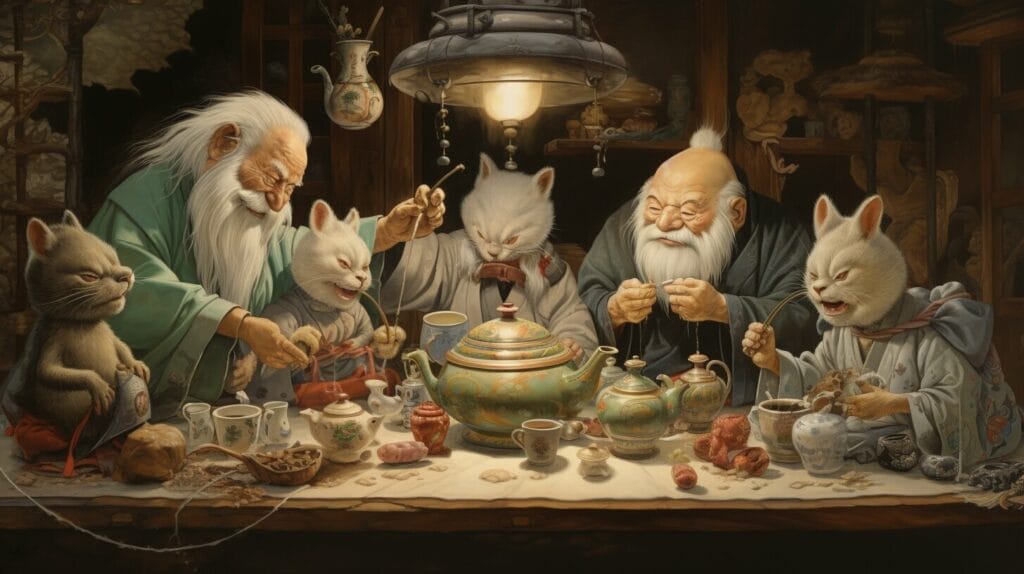
These enchanted creatures are known for their mischievous nature and often play pranks on humans. They may rearrange household items, cause minor disturbances, or even come to the aid of those who treated their objects with care and respect. Tsukumogami are also known to disguise themselves as humans or animals, adding an element of mystery and intrigue to their stories.
| Object | Tsukumogami Form | Abilities |
|---|---|---|
| Umbrella | Tsukumogami | Ability to fly and create protective barriers |
| Teapot | Bunbuku Chagama | Ability to transform into a raccoon dog and pour tea |
| Scroll | Kusazuribake | Ability to transform into a creature resembling a grass mat |
Legend has it that the Tsukumogami’s transformation occurs on the night of New Year’s Day, known as “Tsukumogami no Hi”. It is believed that at the stroke of midnight, when the barrier between the spirit world and the human world is thinnest, these inanimate objects awaken and gain a spirit of their own.
The concept of Tsukumogami not only reflects the animistic beliefs deeply ingrained in Japanese culture but also serves as a reminder to value and appreciate the objects that surround us. It encourages a sense of gratitude and respect for the items we use in our daily lives, as they may hold more significance than meets the eye.
As you embark on this journey through the world of Tsukumogami, let your imagination roam and marvel at the enchanting tales of these mythical creatures. From a simple teapot to a humble scroll, ordinary objects can transform into extraordinary beings, adding a touch of magic to the everyday.
Japanese Mythical Creatures in Art
Immerse yourself in the captivating world of Japanese art, where mythical creatures come to life in vibrant paintings, intricate sculptures, and popular anime and manga. Japanese mythical creatures, such as Kitsune, Tanuki, Tengu, Kappa, and Tsukumogami, have long been a source of inspiration for artists across different mediums, showcasing the rich cultural heritage and imaginative prowess of Japan.
In traditional Japanese paintings, known as “ukiyo-e,” these mythical creatures often take center stage, depicting their enchanting presence and symbolic significance. Artists skillfully portray the mischievous nature of Kitsune, the transformative abilities of Tanuki, and the fierce and majestic essence of Tengu. These artworks not only showcase the creatures themselves but also provide a glimpse into the beliefs and values of Japanese society.
In addition to paintings, Japanese mythical creatures have found their way into modern art forms, such as anime and manga. Anime series like “Naruto” and “Inuyasha” have introduced these captivating creatures to a global audience, further enhancing their popularity and influence. The visually stunning illustrations and animations bring these mythical beings to life, captivating viewers with their intricate details and dynamic storytelling.
| Japanese Mythical Creatures in Art | Art Medium |
|---|---|
| Kitsune | Traditional Paintings, Anime, Manga |
| Tanuki | Traditional Paintings, Sculptures, Anime, Manga |
| Tengu | Traditional Paintings, Anime, Manga |
| Kappa | Traditional Paintings, Anime, Manga |
| Tsukumogami | Traditional Paintings, Sculptures, Anime, Manga |
Japanese art not only captures the physical appearance of these creatures but also celebrates the deep cultural significance they hold. Whether displayed in galleries, adorning merchandise, or even tattooed on enthusiasts, Japanese mythical creatures continue to inspire and captivate people around the world, providing a glimpse into the fascinating world of Japanese folklore.
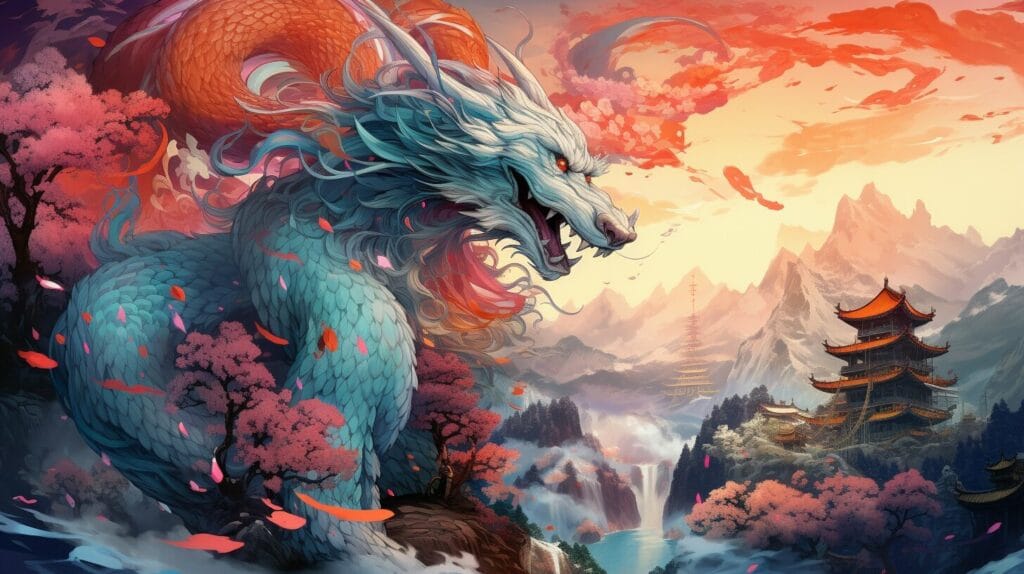
“Japanese art has a unique ability to breathe life into mythical creatures, making them almost tangible. It allows us to connect with the rich cultural heritage of Japan and experience the magic and wonder of these creatures firsthand.” – Art enthusiast
“The intricate details and vibrant colors found in Japanese art enhance the essence of mythical creatures, making them even more captivating and awe-inspiring. It’s truly a testament to the creativity and talent of Japanese artists.” – Art critic
The Influence of Japanese Mythical Creatures in Pop Culture
Explore the widespread impact of Japanese mythical creatures in modern pop culture, where these enchanting beings continue to inspire and entertain. Japanese mythical creatures, such as Kitsune, Tanuki, Tengu, Kappa, and Tsukumogami, have captivated people’s imaginations for centuries with their unique stories and characteristics.
These magical creatures have not only influenced traditional art forms, such as paintings and sculptures, but they have also made a significant mark in contemporary forms of expression, including anime, manga, video games, movies, and even fashion and design.
From iconic characters like the nine-tailed Kitsune, known for its shape-shifting abilities, to the mischievous Tanuki and its transformative powers, Japanese mythical creatures have become beloved figures in pop culture worldwide. They have inspired countless stories, characters, and even entire franchises that continue to thrive and capture the hearts of fans around the globe.
The enduring allure of Japanese mythical creatures in pop culture can be attributed to their rich symbolism, fascinating mythology, and their ability to tap into universal themes of magic, transformation, and the supernatural. Through their representation in various forms of media, these mythical creatures have become ambassadors of Japanese culture and have contributed to the global appreciation and understanding of the country’s folklore and traditions.

| Mythical Creature | Media Representations | Notable Examples |
|---|---|---|
| Kitsune | Anime, manga, video games, movies | Ninetales (Pokémon), Kurama (Naruto) |
| Tanuki | Anime, manga, movies | Tom Nook (Animal Crossing), Mamoru Torigai (Pom Poko) |
| Tengu | Anime, manga, video games | Hanzo (Overwatch), Yasuo (League of Legends) |
| Kappa | Anime, manga, video games | Kappa Mikey (TV series), Kapp’n (Animal Crossing) |
| Tsukumogami | Anime, manga, video games | Tsukuyomi (Naruto), Tsukumogami Kashimasu (TV series) |
Japanese mythical creatures have left an indelible mark on pop culture, serving as a constant source of inspiration and fascination. As fans continue to engage with the captivating stories and imagery associated with these creatures, their influence shows no signs of waning. Whether it’s through animated adventures, immersive video games, or stylish fashion trends, Japanese mythical creatures will always have a place in the hearts and minds of those who appreciate the magic they bring to our modern world.
Recognizing Ancient Japanese Folklore
Take a step back in time and immerse yourself in the ancient Japanese folklore that laid the foundation for the captivating mythical creatures we know today. Ancient Japanese folklore is a treasure trove of legends and stories that have been passed down through generations, shaping the rich and diverse culture of Japan. Within this folklore, a multitude of mythical creatures have emerged, each with its own unique attributes and significance.
One such creature is the Kitsune, a fox-like being known for its shape-shifting abilities and cunning nature. In Japanese folklore, Kitsune are believed to possess great intelligence and magical powers, often portrayed as mischievous or benevolent beings. These fascinating creatures continue to captivate people’s imagination, making their way into various forms of art and popular culture.
Another mythical creature of ancient Japanese folklore is the Tanuki, a creature resembling a raccoon dog. Known for its mischievous nature and transformative abilities, the Tanuki has become a prominent figure in Japanese folklore and is often associated with good fortune. Its whimsical appearance and playful demeanor have made it a beloved character in Japanese art and folklore.
| Mythical Creature | Characteristics | Significance |
|---|---|---|
| Kitsune | Shape-shifting abilities, mischievous or benevolent nature | Symbolizes intelligence and magical powers |
| Tanuki | Mischievous nature, transformative abilities | Associated with good fortune |
The Tengu is another prominent creature in Japanese folklore known for its bird-like appearance and both benevolent and malevolent characteristics. Often depicted as guardians of mountains and forests, the Tengu hold a significant place in Japanese mythology. With their long noses and fierce demeanor, they have inspired countless works of art and continue to be a source of fascination.
As we delve deeper into ancient Japanese folklore, we uncover the mysterious Kappa, water-dwelling creatures known for their mischievous behavior and obsession with cucumbers. These enigmatic beings are believed to possess great strength and supernatural powers, making them both feared and respected in Japanese culture.
Embracing the Wonder of Ancient Japanese Folklore
Ancient Japanese folklore is a testament to the creativity and imagination of a culture steeped in tradition and mythology. The myths and legends that have been passed down through centuries continue to captivate and inspire people around the world. From Kitsune and Tanuki to Tengu and Kappa, these mythical creatures represent the rich tapestry of Japanese culture and remind us of the enduring allure of ancient folklore.
So, take a moment to appreciate the wonder of ancient Japanese folklore and the mythical creatures that have captured our imaginations for centuries. They are more than just fictional beings; they are a reflection of the beliefs, values, and traditions that have shaped Japanese society. Let us continue to celebrate and embrace the magic of these captivating creatures.
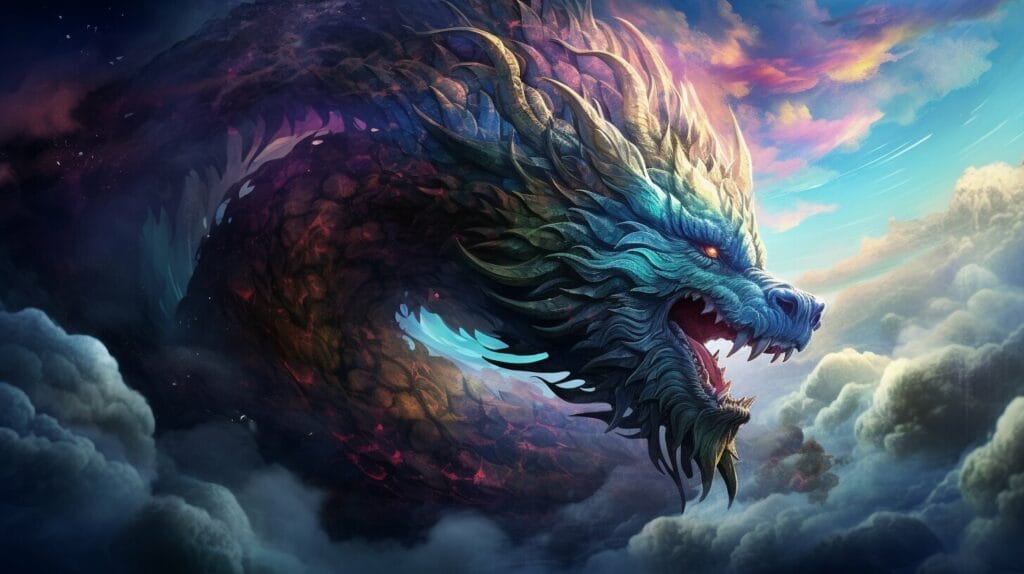
Uncover the captivating legends and mysterious nature of yokai, the supernatural creatures that have intrigued and terrified people in Japanese folklore. These mythical beings come in various forms and possess a wide range of powers, from mischievous pranks to malevolent acts.
One of the most well-known yokai is the Kitsune, a fox-like creature with shape-shifting abilities. Kitsune are often portrayed as mischievous tricksters, capable of taking on human form and manipulating their surroundings. They are associated with both good and evil, their actions guided by their own whims and desires. (Source: Yokai.com)
“Beware the mischievous Tanuki,” warns traditional folklore. The Tanuki, resembling a raccoon dog, is known for its playful nature and transformative abilities. They are often depicted as jolly, pot-bellied creatures, wearing a straw hat and carrying a bottle of sake. Tanuki are believed to bring good fortune, but their mischievous pranks can sometimes cross the line into trickery and deception. (Source: Hyakumonogatari.com)
The Tengu, another prominent yokai, takes the form of a bird-like creature. These legendary beings possess both benevolent and malevolent characteristics. In some legends, Tengu are revered as protectors of the mountains, while in others, they are seen as dangerous and vengeful spirits. They are often depicted with wings, long noses, and carrying a fan or a weapon. (Source: Yokai.com)
The Mysterious Kappa
The Kappa is a water-dwelling yokai known for its mischievous behavior. These creatures are often depicted as small, green-skinned creatures with a turtle-like shell on their backs and a dish-like depression on their heads, which holds water. The Kappa is notorious for its obsession with cucumbers and its tendency to drag unsuspecting victims into the water. Approach their habitat with caution! (Source: Yokai.com)
| Yokai | Description |
|---|---|
| Kitsune | Fox-like creature with shape-shifting abilities |
| Tanuki | Raccoon dog-like creature known for mischievous nature and transformative abilities |
| Tengu | Bird-like yokai with both benevolent and malevolent characteristics |
| Kappa | Water-dwelling creature with an obsession for cucumbers |
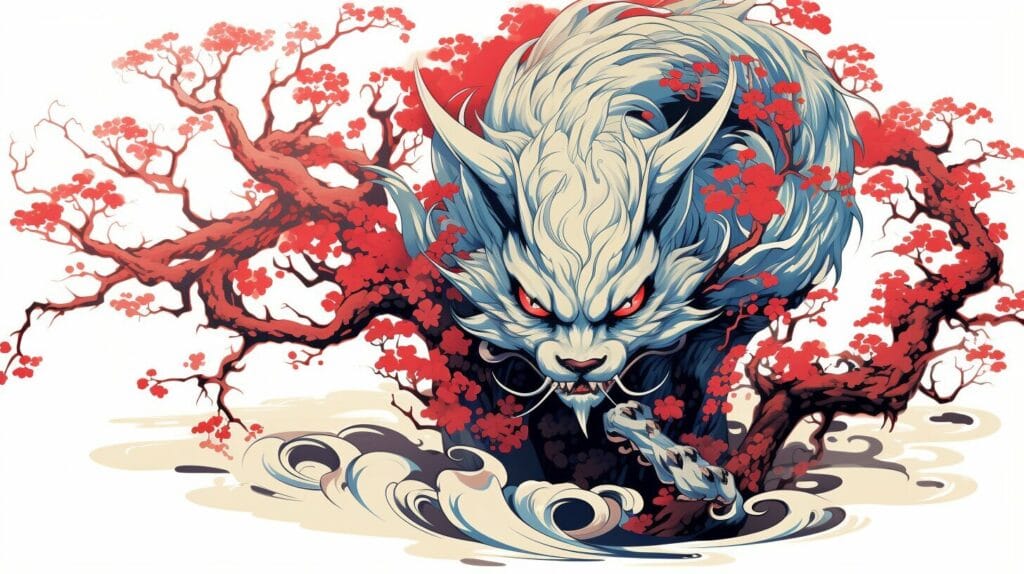
These legendary creatures from Japanese folklore continue to capture the imagination of people around the world. Their stories have been passed down through generations, shaping Japan’s rich and diverse culture. Whether they bring fortune or mischief, yokai play a significant role in Japanese mythology and leave an enduring mark on pop culture as well.
The Enduring Allure of Japanese Folklore Creatures
Discover the enduring allure of Japanese folklore creatures, which continue to mesmerize and enthrall people of all ages with their enchanting stories and symbolism. From the mischievous Kitsune to the transformative Tanuki, these mythical creatures have captivated people’s imagination for centuries.
One of the most famous Japanese folklore creatures is the Kitsune, a fox-like creature known for its shape-shifting abilities and trickster nature. With its ability to transform into a beautiful woman or a cunning trickster, the Kitsune has been a popular subject in traditional Japanese art and literature.
Another intriguing creature is the Tanuki, a mythical creature resembling a raccoon dog. Known for its mischievous and playful nature, the Tanuki has been deeply rooted in Japanese folklore. With its transformative abilities and mischievous antics, the Tanuki has become a beloved character in numerous folk tales and cultural references.
The Tengu, a bird-like creature with both benevolent and malevolent characteristics, is another fascinating creature in Japanese mythology. Often depicted with wings and a long nose, the Tengu has been a popular subject in traditional Japanese art and literature, symbolizing both wisdom and mischief.
“Japanese folklore creatures continue to captivate people’s imagination and are a significant part of Japan’s rich and diverse culture.”
The allure of Japanese folklore creatures extends beyond traditional art, as they have also made their way into modern pop culture. From video games to movies and fashion, these creatures have influenced and shaped popular culture worldwide. Their unique characteristics and captivating stories have inspired countless works, sparking the imagination of artists and creators around the globe.
As we delve into the rich history of Japanese folklore, we can appreciate the enduring allure of these mythical creatures. They continue to fascinate and charm us with their enchanting tales, leaving an indelible mark on Japanese culture and the world at large.
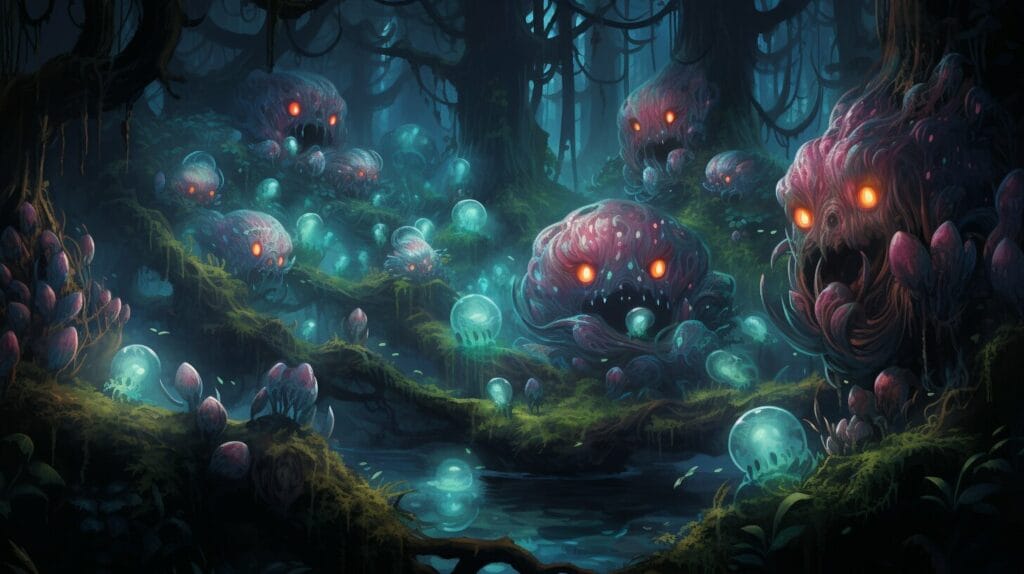
| Folklore Creature | Description |
|---|---|
| Kitsune | A fox-like creature with shape-shifting abilities often depicted as mischievous or benevolent. |
| Tanuki | A mythical creature resembling a raccoon dog known for its mischievous nature and transformative abilities. |
| Tengu | A legendary creature often depicted as a bird-like creature with both benevolent and malevolent characteristics. |
| Kappa | A water-dwelling creature known for its mischievous behavior and obsession with cucumbers. |
| Tsukumogami | Objects that come to life after reaching a certain age or being neglected, with significance in Japanese folklore. |
Embracing the Wonder of Japanese Mythical Creatures
This is a fascinating journey through the world of Japanese mythical creatures, let us embrace the wonder and magic these enchanting beings have brought to Japan’s rich cultural tapestry.
Japanese mythical creatures, such as Kitsune, Tanuki, Tengu, Kappa, and Tsukumogami, have captivated people’s imagination for centuries. Each creature possesses its own unique story, characteristics, and significance in Japanese folklore and mythology. From the mischievous Kitsune with its shape-shifting abilities to the playful and transformative Tanuki, these creatures have become beloved figures in Japanese culture.
These mythical creatures have not only been a source of inspiration in traditional art forms such as paintings and sculptures, but they have also found their way into modern popular culture, including anime, manga, and video games. Their enduring allure has transcended time and borders, influencing and shaping various aspects of pop culture worldwide.
Japanese mythical creatures are not merely fictional characters; they reflect the deep-rooted beliefs, values, and traditions of the Japanese people. They are a testament to the rich history and diverse heritage of Japan, reminding us of the fascinating stories and legends that have been passed down through generations. Their continued presence in contemporary society showcases the enduring fascination and reverence for these captivating creatures.
So, let us embrace the wonder of Japanese mythical creatures and appreciate the cultural significance they hold. Whether they appear in ancient folklore or modern entertainment, these enchanting beings continue to captivate us with their enduring magic and contribute to the cultural tapestry of Japan.
Are you interested in mythical art? Check out my article about mythical art and artists.
Questions people also ask:
Q: What are Japanese mythical creatures?
A: Japanese mythical creatures are supernatural beings or creatures that are prominent in Japanese folklore and mythology. They have unique characteristics and stories that make them distinct and fascinating.
Q: What are some examples of Japanese mythical creatures?
A: Some examples of Japanese mythical creatures include Kitsune (fox-like creatures with shape-shifting abilities), Tanuki (mischievous creatures resembling raccoon dogs), Tengu (bird-like yokai), Kappa (water-dwelling creatures), and Tsukumogami (objects that come to life).
Q: How are Japanese mythical creatures depicted in art?
A: Japanese mythical creatures have been depicted in various forms of art, including traditional paintings and sculptures. They are also popular subjects in anime and manga, where they are reimagined and given new interpretations.
Q: What is the significance of Japanese mythical creatures in Japanese culture?
A: Japanese mythical creatures are an important part of Japan’s rich and diverse culture. They have been passed down through generations and are often associated with moral lessons, natural phenomena, or spiritual beliefs.
Q: How have Japanese mythical creatures influenced pop culture?
A: Japanese mythical creatures have had a significant influence on popular culture worldwide. They have inspired various forms of media, including video games, movies, fashion, and design, and continue to captivate people’s imagination.
The fox from Naruto, the popular anime show is known as the Nine-Tailed Fox or Kurama. Kurama is a powerful and ancient tailed beast that was sealed within the main character, Naruto Uzumaki, shortly after his birth. It is one of the most feared and destructive beasts in the Naruto world.
Kurama is depicted as a giant fox with nine tails, giving it immense power and chakra (a form of energy). It has a red-orange fur with distinct markings on its face and body. Due to its immense power, Kurama was seen as a threat to the peace and balance of the Naruto world, and it was sealed away by a legendary ninja to protect the village.
However, as the series progresses, Naruto forms a bond with Kurama, and they learn to cooperate and work together. Naruto eventually gains control over the Nine-Tailed Fox’s power and uses it to protect his friends and fight against the various villains in the series.
Kurama’s presence and influence play a significant role in Naruto’s growth as a character and his journey to becoming the strongest ninja in his village.
Q: Why do Japanese mythical creatures continue to fascinate people?
A: Japanese mythical creatures possess a certain allure and mystery that captures people’s imagination. Their unique characteristics, stories, and connection to Japanese culture make them enduringly fascinating to people worldwide.
From fire-breathing dragons to shape-shifting spirits, Asian mythical creatures hold secrets you’ve never heard—discover them here: Asian Mythical Creatures
